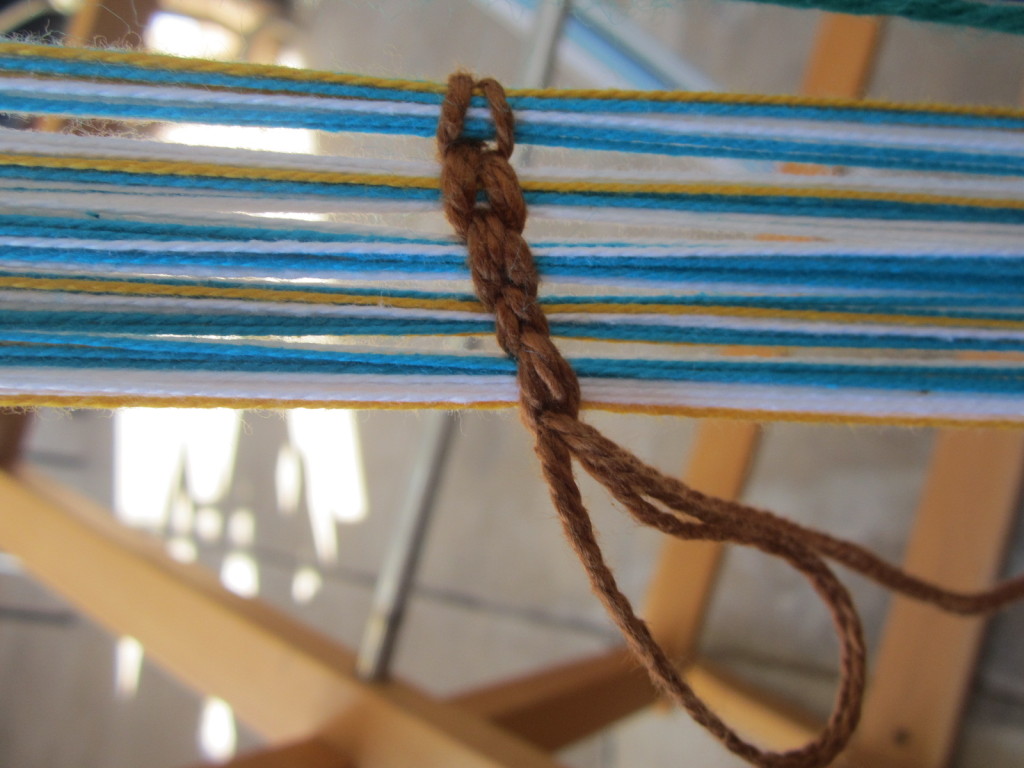When I was a teenager, my family went to Finland for a summer vacation to visit my uncle and aunt. It was our first time visiting Europe. One activity we did was weaving at a crafts center in Turku. We paid to weave for two or three days. You pick your project and yarn. The staff put the warp on the loom and teach you how to weave the weft. You can see the blanket I made here. I still can’t believe I made it! We were told that it was a popular activity with young women who were building a trousseau or hope chest of linens for their adult life.
Since then, I have been interested in weaving. Earlier this year, I did my Weaving a Life class, but that was about tapestry weaving or using a smaller loom to make a picture in the weaving. It does not use a big floor or table loom with hundreds of moving pieces. I still wanted to learn that type of weaving. So when I recently left National Wildlife Federation, one of my first priorities with my new found brain space was to take the beginning weaving class.
Choosing My Project

The class is at Workhouse Arts Center, taught by Marilyn Harrington. So in Finland, I did not learn how to set up a loom, only how to press the pedals and push the shuttle back and forth (the actual weaving part of the project). This class is much more involved and interesting. I love the density of the class – filled with layers of information about evaluating yarns, designing projects, cleaning looms etc.
In last week’s class, Marilyn showed us a bunch of weaving projects that we could learn how to make. I chose a cotton towel because cotton seems like the easiest to learn with, and I didn’t want a cotton scarf. My towel will look something like this one by Marilyn:

Calculating My Yarn Needs
A lot of math is involved with planning your warp. It took me two tries to get it right. I had to calculate how many vertical (warp) and horizontal (weft) pieces of yarn make up my project, and draw a picture of it to ensure it all fits together. I had to figure out how densely I wanted to weave based on what kind of yarn I used and what kind of reed goes with that yarn. I had to translate inches of yarn into pounds of yarn because you buy weaving yarn by the pound. I plan to weave two towels from the same warp, and this uses about 1/2 pound of yarn, but I had to buy three pounds of yarn to get the three colors. A pound of this type of cotton yarn costs about $20.
Making the Warp
This week, our goal was to make our warp. My warp will be 18 inches wide. I am using a type of yarn that puts 16 strings of yarn (or ends) per inch, so that means my warp will have 288 strings! Wow. You don’t sit there measuring out 288 strings. Instead you use a tool called a warp board or a warp mill.
A warp board looks like a rectangle or square piece of wood with pegs sticking up. You move the pegs to get the warp to the calculated length. In this picture, Marilyn is setting up a warp mill, which is a faster way to make a warp because you spin it around quickly. Behind her on the wall is a warp board, which relies on winding your yarn back and forth between the pegs.

As you wrap your warp around the warp board or mill, you have to remember two important things:
1) The warp has one cross in it – The cross is the whole point. It ensures that when you weave your items and press on those pedals, the right spots open up and close.

2) You tie off a little bundle of warp strings that represent one inch of your warp – Every time I wrap 16 strings around the board or mill, I tie a little piece of yarn around it that looks like this – it’s called a “counting chain” and it tells me how much of my warp I have completed. It works a bit like the loops in crochet.

I managed to wrap seven inches of my warp in about two hours, but I was getting faster as the time went on, so I’m hopeful I can do the other 11 inches in about 2.5 hours. Once I finished wrapping that much warp, I tied a bunch of bows all around the loop to keep things in order and then I gently removed it from the warping mill. Then I looped it upon itself and this is what it looks like now – hard to believe it is going to work out!

My Own Floor Loom
So if it was not exciting enough to learn this skill, something else happened that is hard to believe. When I went to meet Marilyn and sign up for her weaving class, I asked for advice about buying a loom. Looms cost $2000-5000 new, and at least $500 used. I had no idea how to even tell if a loom was in good shape. Marilyn told me she had a loom in her garage that she was not using and I could have it if I just picked it up. For real? She was that generous with a person she just met. I still can’t believe it. Since the loom was in pieces, I could easily fit it in my Honda Fit and bring it home:

I believe this is a loom called a Leclerc Fanny II made in Plessisville, Quebec. I cannot find any inscription on it yet even though I have looked carefully at the pieces. I downloaded instructions from the web on how to put it together. First though, I need to clean the metal parts with something called Naval Jelly. That is most critical thing to fix because rusty metal parts might cause the loom or yarn to get stuck in the wrong position when you press the pedals.
Pretty amazing life!!!! I feel very lucky to be able to take the class and to set up this loom!



